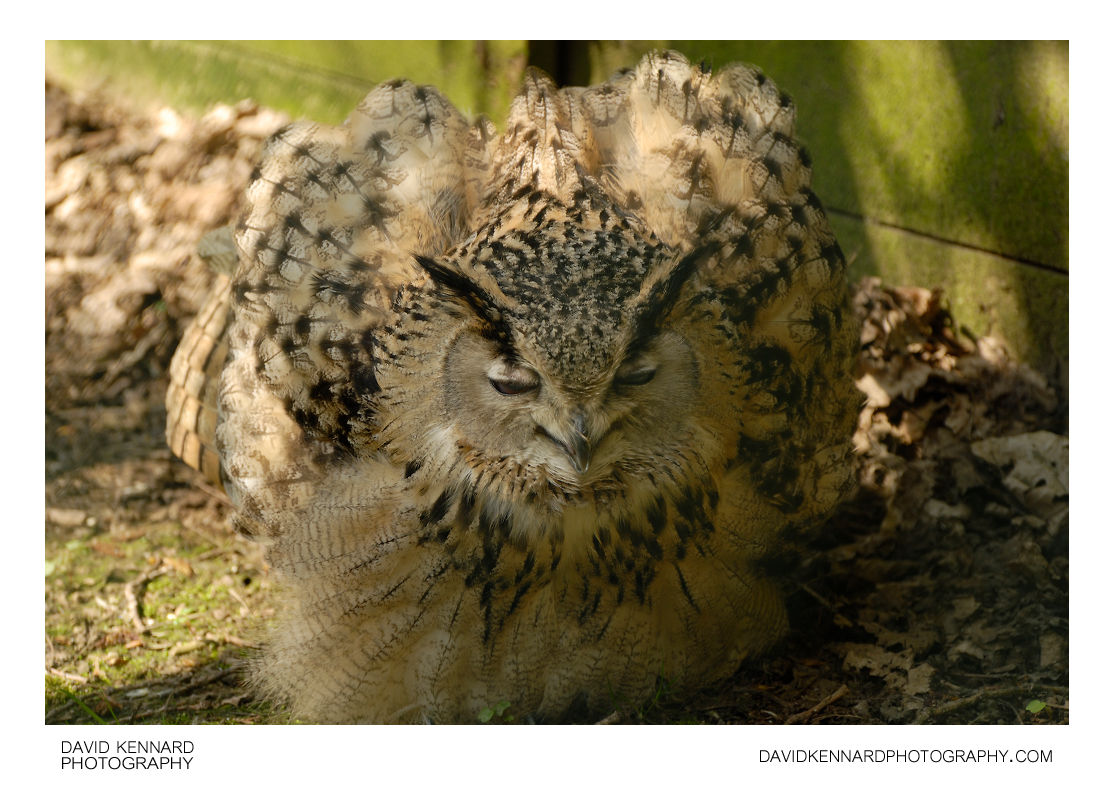Turkmenian Eagle Owl (Bubo bubo turcomanus)

Description
- Title:
- Turkmenian Eagle Owl (Bubo bubo turcomanus)
- Caption / Description:
-
The Turkmenian Eagle Owl (Bubo bubo turcomanus) is a sub-species of the Eurasian Eagle-owl (Bubo bubo). They originate from Kazakhstan, where they live around rocky areas and cliffs.
The Eagle Owl is a large and powerful bird, smaller than the Golden Eagle but larger than the Snowy Owl. It is sometimes titled the world's largest owl, but so is the Blakiston's Fish Owl, which is slightly bigger on average. The Eagle Owl has a wingspan of up to 138–200 cm (55–79 in) and measures 58–73 cm (23–29 in) long. Females weigh 1.75-4.2 kg (3.9-9.4 lbs) and males weigh 1.5-3.2 kg (3.3-7 lbs). In comparison, the common Barn Owl weighs about 500 grams (1.1 lbs). It mainly feeds on small mammals, but can kill prey up to the size of foxes and young deer (up to 10 kg/22 lb), if taken by surprise. Larger prey (over 3 kg/7 lb) is consumed on the ground which leaves the bird vulnerable (for example to foxes).
The call of the Eagle Owl is a deep resonant “ooh-hu” with emphasis on the first syllable for the male, and a more high-pitched uh-Hu for the female (in German and Hungarian, the name of this bird is "Uhu" and the Dutch name is “Oehoe”). Each member of an Eagle Owl population can be identified by means of its vocalizations.
The size, ear tufts and orange eyes make this a distinctive species. It has a strong direct flight. The ear tufts of males are more upright than those of females.
Description from Wikipedia: http://en.wikipedia.org/wiki/Eurasian_Eagle-owl
- Tags / Keywords:
-
- Biota
- Life
- Vitae
- Eukaryota
- Animalia
- Animals
- Chordata
- Chordates
- Aves
- Birds
- Strigiformes
- Owls
- Strigidae
- Typical owls
- True Owls
- Bubo
- Horned Owls
- Eagle Owls
- Bubo bubo
- Eurasian Eagle-owl
- Bubo bubo turcomanus
- Turkmenian Eagle Owl
Admin
- Date Original Photo Taken:
- Original File Name:
- _DSC8784.NEF
- Event:
- Rating:
- Date this image added/last updated on website:
- Original File Dimensions:
- 3872px x 2592px
- File Type:
- JPEG
- Color Mode:
- RGB
- Original Image Color Profile:
- Nikon Adobe RGB 4.0.0.3001
Location
- Location Shown:
-
- Sublocation:
- Rutland Falconry & Owl Centre
- City:
- Oakham
- Province/State:
- Rutland
- Country:
- United Kingdom
- World Region:
- Europe
- Location Created:
-
- Sublocation:
- Rutland Falconry & Owl Centre
- City:
- Oakham
- Province/State:
- Rutland
- Country:
- United Kingdom
- World Region:
- Europe
- Geo-location:
- 52.681907060361, -0.66308447551389 View on map
Rights
- Copyright Status:
- Copyrighted
- Licensing Status:
- Rights Managed
- Available for Editorial Use:
- Yes
- Available for Commercial Use:
- No
- Copyright Notice:
- © 2010 Dave Kennard
Camera Data
- Date Digital Resource was created:
- Shutter speed:
- 1⁄80 s
- Aperture:
- f/5
- Camera Model:
- Nikon D200
- ISO:
- 160
- Exposure Compensation:
- 0
- Focal Length:
- 180mm
- Focal Length (35mm equiv.):
- 270mm
- Metering Mode:
- Multi-segment
- Flash:
- No Flash
- Exposure Mode:
- Auto
- White Balance:
- Manual
- Light Source:
- Cloudy
- Exposure Program:
- Aperture-priority AE
Additional shooting metadata
- Lens:
- Nikon AF-S VR Zoom Nikkor ED 70-300mm F4.5-5.6G(IF)
- Filters used:
-
- B+W UV 010 MRC
- Additional Optics used:
- Setup:
- Handheld
Post Processing
- Image Modified:
- Software used:
-
- Nikon Capture NX 2
- Post Processing:
